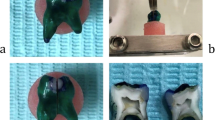Abstract
Purpose
Microleakage is one of the most important problems that can adversely affect the longevity of dental restorations. The aim of this in vitro study is to assess microleakage of a new BioActive-Restorative composite (ACTIVA™, Pulpdent, USA), in comparison to standard adhesive materials used in restoring class II cavities in primary teeth.
Design
One hundred and four extracted human primary molars were randomly allocated into three groups. In each group, class II cavities were prepared and restored with one of the three restorative materials: ACTIVA, Filtek Z250, or Vitremer. Microleakage was assessed using dye penetration method under a stereomicroscope. Chi-square test was used followed by pairwise comparisons to assess the association between microleakage and the materials used. A significance level of 0.05 was assumed throughout the study.
Results
According to leakage analysis per tooth, there were no statistically significant differences in microleakage percentages between ACTIVA and both Filtek Z250 and Vitremer. Leakage analysis per surfaces showed significantly higher leakage percentages in ACTIVA compared to Filtek Z250 at both occlusal and cervical margins and lower than Vitremer at occlusal margin.
Conclusion
ACTIVA can be a potential restorative material in class II cavities in primary molars; clinical studies are recommended.



Similar content being viewed by others
References
Bala O, Uctasli MB, Unlu I. The leakage of class II cavities restored with packable resin-based composites. J Contemp Dent Pract. 2003;4(4):1–11.
Bernardo M, Luis H, Martin MD, et al. Survival and reasons for failure of amalgam versus composite posterior restorations placed in a randomized clinical trial. J Am Dent Assoc. 2007;138(6):775–83.
Brackett WW, Gilpatrick RO, Gunnin TD. Effect of finishing method on the microleakage of class V resin composite restorations. Am J Dent. 1997;10(4):189–91.
Castro A, Feigal RE. Microleakage of a new improved glass ionomer restorative material in primary and permanent teeth. Paediatr Dent. 2002;24(1):23–8.
Crim GA, Mattingly SL. Evaluation of two methods for assessing marginal leakage. J Prosthet Dent. 1981;45(2):160–3.
Croll TP, Berg JH, Donly KJ. Dental repair material: a resin-modified glass ionomer bioactive ionic resin-based composite. Compend Cont Educ Dent. 2015;36(1):60–5.
Dennison JB, Sarrett DC. Prediction and diagnosis of clinical outcomes affecting restoration margins. J Oral Rehabil. 2012;39(4):301–18.
Donly KJ, Segura A, Kanellis M, Erickson RL. Clinical performance and caries inhibition of resin-modified glass ionomer cement and amalgam restorations. J Am Dent Assoc. 1999;130(10):1459–66.
Fabianelli A, Pollington S, Davidson CL, Cagidiaco MC, Goracci C. The relevance of microleakage studies. Int Dent SA. 2007;9(3):64–74.
Frankenberger R, Kramer N, Lohbauer U, Nikolaenko SA, Reich SM. Marginal integrity: is the clinical performance of bonded restorations predictable in vitro? J Adhes Dent. 2007;9(Suppl 1):107–16.
Gladys S, Van Meerbeek B, Lambrechts P, Vanherle G. Microleakage of adhesive restorative materials. Am J Dent. 2001;14(3):170–6.
Haller B, Hofmann N, Klaiber B, Bloching U. Effect of storage media on microleakage of five dentin bonding agents. Dent Mater. 1993;9(3):191–7.
Heintze SD. Clinical relevance of tests on bond strength, microleakage and marginal adaptation. Dent Mater. 2013;29(1):59–84.
Hickel R, Roulet JF, Bayne S, et al. Recommendations for conducting controlled clinical studies of dental restorative materials. Clin Oral Investig. 2007;11(1):5–33.
Irie M, Suzuki K. Effects of delayed polishing on gap formation of cervical restorations. Oper Dent. 2002;27(1):59–65.
Khoroushi M, Karvandi TM, Kamali B, Mazaheri H. Marginal microleakage of resin-modified glass-ionomer and composite resin restorations: effect of using etch-and-rinse and self-etch adhesives. Indian J Dent Res. 2012;23(3):378–83.
Kidd EA. Microleakage: a review. J Dent. 1976;4(5):199–206.
Leinfelder KF. A conservative approach to placing posterior composite resin restorations. J Am Dent Assoc. 1996;127(6):743–8.
Longman CM, Pearson GJ. Variations in tooth, surface temperature in the oral cavity during fluid intake. Biomaterials. 1987;8(5):411–4.
McHugh ML. Interrater reliability: the kappa statistic. Biochemia Medica. 2012;22(3):276–82.
Nozaka K, Suruga Y, Amari E. Microleakage of composite resins in cavities of upper primary molars. Int J Paediatr Dent. 1999;9(3):185–94.
Pulpdent® Corporation. Products—ACTIVA™ BioACTIVE RESTORATIVE™—white paper. 2015–2016. http://www.pulpdent.com/wp-content/uploads/2015/12/ACTIVA-White-Paper-XF-VWP5-REV-9-2016.pdf. Accessed 6 Jun 2017.
Srinivasan V, Deery C, Nugent Z. In-vitro microleakage of repaired fissure sealants: a randomized, controlled trial. Int J Paediatr Dent. 2005;15(1):51–60.
Van Dijken JW, Pallesen U. Long-term dentin retention of etch-and-rinse and self-etch adhesives and a resin-modified glass ionomer cement in non-carious cervical lesions. Dent Mater. 2008;24(7):915–22.
Wilder AD, Swift EJ, May KN, Thompson JY, McDougal RA. Effect of finishing technique on the microleakage and surface texture of resin-modified glass ionomer restorative materials. J Dent. 2000;28(5):367–73.
Yap AU. Effects of storage, thermal and load cycling on a new reinforced glass–ionomer cement. J Oral Rehabil. 1998;25(1):40–4.
Yap AU, Mok BY. Surface finish of a new hybrid aesthetic restorative material. Oper Dent. 2002;27(2):161–6.
Yap AU, Lim CC, Neo JC. Marginal sealing ability of three cervical restorative systems. Quintessence Int. 1995;26(11):817–20.
Yeolekar TS, Chowdhary NR, Mukunda KS, Kiran NK. Evaluation of microleakage and marginal ridge fracture resistance of primary molars restored with three restorative materials: a comparative in vitro study. Int J Clin Paediatr Dent. 2015;8(2):108–13.
Yikilgan İ, Akgul S, Özcan S, Bala O, Ömürlü H. An in vitro evaluation of the effects of desensitizing agents on microleakage of class V cavities. J Clin Exp Dent. 2016;8(1):e55.
Acknowledgements
This study was supported by Jordan University of Science and Technology (Grant no. 2016/243).
Author information
Authors and Affiliations
Contributions
AIA conceived the design, collected the data, and drafted the manuscript. SHA-J led the writing, revised the manuscript critically, and supervised the work. HAA analyzed the data.
Corresponding author
Ethics declarations
Conflict of interest
Authors have no conflict of interest to declare in relation to any of the materials in this study
Additional information
Publisher’s Note
Springer Nature remains neutral with regard to jurisdictional claims in published maps and institutional affiliations.
Rights and permissions
About this article
Cite this article
Amaireh, A.I., Al-Jundi, S.H. & Alshraideh, H.A. In vitro evaluation of microleakage in primary teeth restored with three adhesive materials: ACTIVA™, composite resin, and resin-modified glass ionomer. Eur Arch Paediatr Dent 20, 359–367 (2019). https://doi.org/10.1007/s40368-019-00428-6
Received:
Accepted:
Published:
Issue Date:
DOI: https://doi.org/10.1007/s40368-019-00428-6




